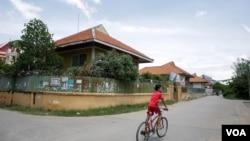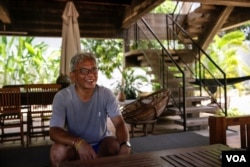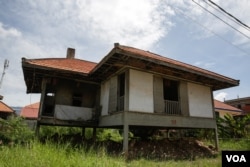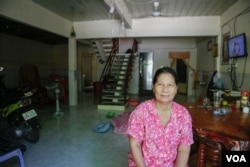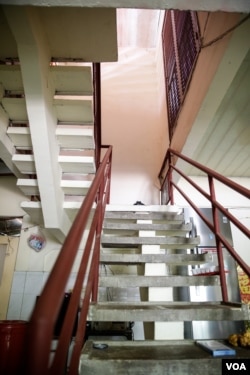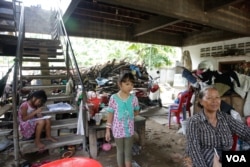Ung Dara Rath Moni spent the morning watering his plants.
In his sixties, Ung spends a lot time taking care of his tropical plants, including mango, banana and bird of paradise flowers.
He lives in a compound known as 100 Houses, a residential area in Phnom Penh’s Teuk Tla designed by renowned architect Vann Molyvann, who died in late September.
In his t-shirt and shorts, the 60-something Ung sits on the ground under his wooden house and tells VOA about how he moved to the area.
“I knew that it was one of his [Vann Molyvann’s] legacies since I was young. And since I love vintage things and also appreciated his legacy, I decided to buy that house,” Ung said. He bought his first house in 1997, then purchased the house next door a few years later.
He merged the two houses into the same property. Though much has been changed in the first house, he tried to keep the second house as close to the original design as possible. He kept the stairs, windows, tiles, and roof in its original form. He said he wants the next generation to see Molyvann’s legacy.
“I know that people these days will not keep it that way. They love new things, and they change even the tiles. If I don't keep it, it will be gone,” Ung added.
100 Houses was built between 1965 and 1967. The National Bank of Cambodia chose Vann Molyvann to work on a private project to build 100 identical houses on a plot for their workers in Teuk Tla, near Phnom Penh International Airport.
The layout is based on the traditional style of Khmer wooden housing. It consists of a small bedroom and a large living room. The extension is separated by a small terrace, with a kitchen and restroom.
The roof juts out past the walls to protect them from rain and sunlight. The stilts lift the house high off the ground, preventing flooding and creating a shaded space below the house.
In each house, a pond was dug either in the front or behind the house. This is for both storing water from rain and to cool down the house. Though, the majority of the ponds have been filled in.
Ung is now increasingly concerned about the lack of conservation of the houses. “The loss is unavoidable,” he said.
Many of the houses are in an advanced state of decay, and many have been significantly altered or completely destroyed.
Villagers say they would like to renovate if they can find the money.
Hak Bopha, 54, a resident of 100 Houses, says she bought the house in 1979 after the fall of the Khmer Rouge regime. She said the air circulation is ingenious and not found in most modern housing.
“I only renovated the lower part of the house, and keep the remaining upper level intact. I changed the window because the wood was decayed. The roof is still in its original layout,” Hak said.
However, she plans to build a new house on the land when she saves enough money. “It can't be kept that long. Many parts are decaying, it is not strong at all. Now the trend here is to demolish and then build a new house.”
Another resident, Mom Sinat, who also moved here in 1979, is also worried about rotten timber. Though the house is still in fairly good condition, she also plans to build entirely new house as soon as she can afford to do so.
“I also want to build a new house if I have money. The concrete is degrading,” Mom said.
In a 2001 interview with the Institute of Art and Culture Reyum, Molyvann said each of his buildings took inspiration from traditional Khmer architecture.
“For example, in the 100 Houses, I took the idea from Khmer houses, but I learned and improvised. For example, Khmer houses’ windows are quite small, so I widened the windows in 100 Houses, which makes the air flow better. Also, Khmer houses' columns are made out of wood, which is decays easily. Instead, I changed to concrete to make it last longer.”
Like many in his profession, Hor Daro, a 25-year-old architect, has huge admiration of Molyvann's works. As an architecture tour guide, he regularly visits the 100 Houses project.
“This work is great because it relates to the way of Khmer people live. The project got inspiration from Khmer houses. It really responded to the Khmer context of living,” he said, adding that the project was also a vision of sustainable living.
While Daro admits that old buildings will eventually be replaced as development continues apace, he urged Cambodians to see value in preserving such iconic pieces of architecture.
“Any country could face this problem. However, it is a matter of how we give the value, to conserve, to maintain for the next generation. So they can see, understand and learn from the legacy, because New Khmer Architecture was created by Cambodians, and it really fit the Khmer context.”




